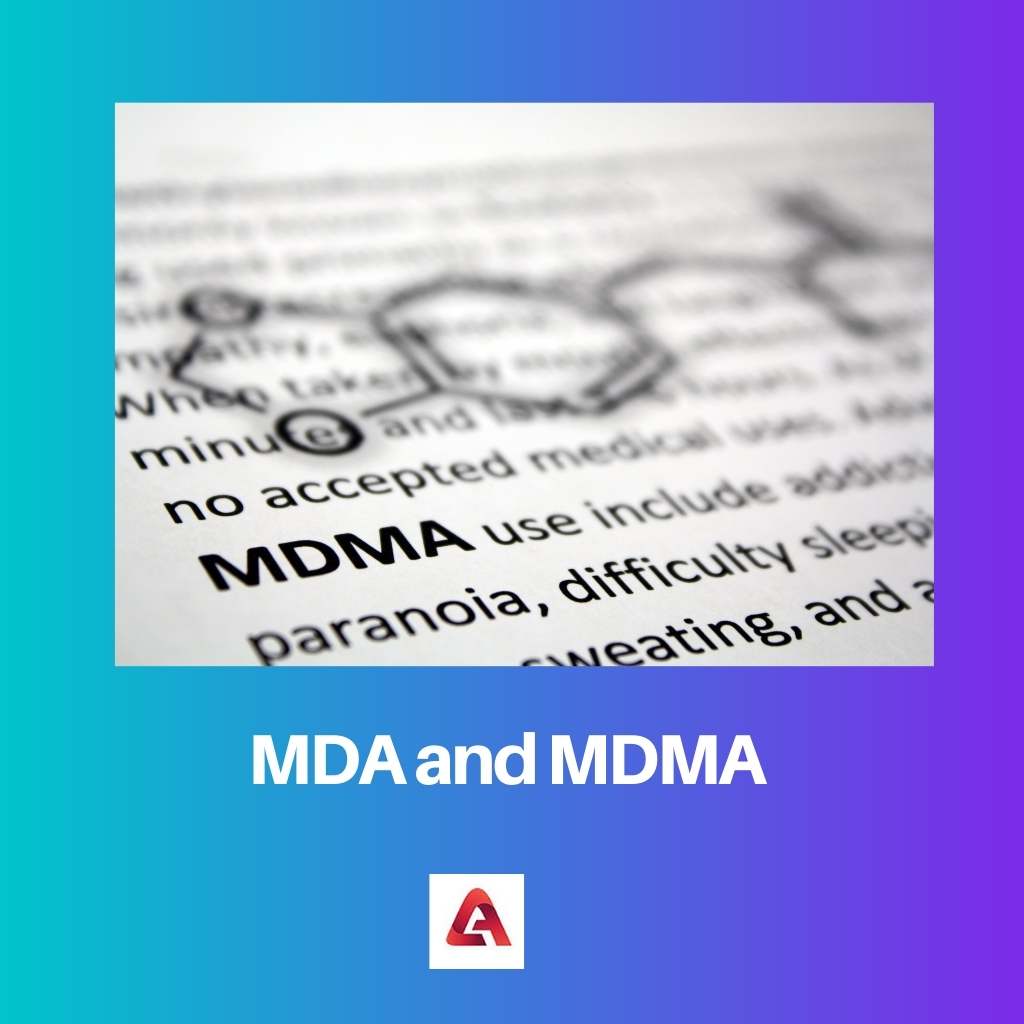MDA and MDMA are both stimulants and psychedelics, in other words. Despite the fact that they’re frequently sold for the same price, they can produce vastly distinct “highs.”
Key Takeaways
- MDA is a psychedelic drug with hallucinogenic effects, while MDMA is an empathogenic drug with euphoric effects.
- MDA has a longer duration of action than MDMA, with effects lasting up to 10 hours.
- MDA possesses more potent visual effects, while MDMA induces stronger feelings of empathy and emotional closeness.
MDA and MDMA
MDA (3, 4-methylenedioxyamphetamine) and MDMA (3, 4-methylenedioxymethamphetamine) are both empathogenic psychoactive substances, but they differ in some ways. MDA is considered to be more stimulating and intense. MDMA is considered to be more entactogenic and euphoric, and empathetic.

Affection and empathy are two emotions that you might have with Sally, along with tremendous pleasure, increased energy, enthusiasm, exhilaration, intimacy, confidence, and so on.
MDMA has stimulant effects, such as greater pleasure and self-confidence and increased vitality. Peacefulness, acceptance, and empathy are some of the psychedelic effects.
Comparison Table
| Parameters of Comparison | MDA | MDMA |
|---|---|---|
| Common Name | Sally | Molly |
| Effects | Psychedelic | Empathogenic |
| Scientific Name | 3,4-methylenedioxyamphetamine | 3,4-methylenedioxymethamphetamine |
| Duration | Up to 6 hours | 3 to 4 hours |
| Stimulant Qualities | Hallucinations, visual distortions, and increased stimulant qualities with focused energy. | Similar but they are toned-down qualities. |
| Neurological Damage | Produces greater neurological damage | Less neurological damage |
| Side Effects | Nausea, euphoria, extreme energy boost, jaw clenching, erectile dysfunction, depression, headaches | Decrease or increase in negative emotions, reduced appetite, memory problems feelings of irritability. |
What is MDA?
Methylenedioxyamphetamine (commonly known as MDA or sass) is an amphetamine-family empathogen-entactogen, psychostimulant, and psychedelic substance that is mostly used recreationally.
MDA is primarily a serotonin-norepinephrine–dopamine-releasing agent in terms of pharmacology (SNDRA). Most nations classify the drug as a controlled substance, making its possession and sale unlawful.
MDA is not as popular as other amphetamines as a recreational stimulant; it is still an important and frequently used drug because it is a principal metabolite, the product of hepatic N-dealkylation, of MDMA (ecstasy).
MDA is now unacceptably used in medicine. Despite being illegal, MDA is purchased, sold, and used as a recreational ‘love drug’ because it improves mood and empathy. MDA can be taken recreationally at doses ranging from 100 to 160 mg.
It’s made by converting safrole to Iso safrole. Isomerization is used to accomplish this. This is then oxidized and transformed to MDA.
It causes nausea, anxiety, decreased appetite, euphoria, and a sense of well-being in the short term. Erectile dysfunction, muscle tension, short-term memory loss, migraines, hangovers, mild depression lasting up to a week, increased energy, and probable liver poisoning are also side effects.

What is MDMA?
MDMA is a psychoactive synthetic substance with a molecular structure resembling the stimulant methamphetamine and the hallucinogen mescaline. Its scientific name is 3-4 methylenedioxymethamphetamine.
MDMA was first developed as an appetite suppressant by a German corporation in 1912.
MDMA causes brain neurons to release neurotransmitters like serotonin, resulting in a high that lasts anywhere from 3 to 6 hours, depending on the person.
MDMA is most found as a tablet or capsule that must be swallowed. It’s also available as a powder, which can be snorted, ingested as a drink, or smoked, but it’s rarely injected.
Some people have reported certain addiction signs and symptoms. Almost 60% of Ecstasy users report experiencing withdrawal symptoms such as exhaustion, loss of appetite, depression, and difficulty concentrating.
Thoughts of intimacy, heightened delight, a distorted sense of time and perception, sexual feelings and wants, increased empathy, increased sensitivity to touch, and so on are some of these feelings.
Main Differences Between MDA and MDMA
- MDA produces greater neurological damage when compared to MDMA
- Common side effects of MDA include euphoria, extreme energy boost, nausea, jaw clenching, depression, erectile dysfunction, and headaches. Common side effects of MDMA include a decrease or increase in negative emotions, reduced appetite, memory problems, and irritability.
- https://journals.sagepub.com/doi/abs/10.2190/DCRP-U22M-AUMD-D84H
- https://www.sciencedirect.com/science/article/pii/S0091305796003346

This article provides important information for readers to evaluate the risks and effects of MDA and MDMA. As always, knowledge is key.
The fact that MDA can produce greater neurological damage than MDMA is alarming. People need to be educated on the potential risks.
I’m surprised to see how different these two drugs are! I wish this article went into more detail about how exactly to differentiate them.
That’s a great point, Tony29! The complexity of these two drugs isn’t fully explained here.
It’s interesting to see how MDMA was initially developed as an appetite suppressant. The history behind these drugs is fascinating.
I had no idea about the origin of MDMA either. Learning about it adds another layer of significance to its use today.
I’m always amazed by people’s desire to take substances like MDA and MDMA for recreational purposes, despite the potential side effects. It’s not worth the risk.
Alison, I completely agree. The risks associated with these substances should not be taken lightly.
Having the comparison table and the detailed information for each drug available in one place is so helpful. It’s great to have all these facts laid out so clearly.